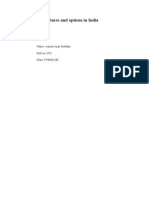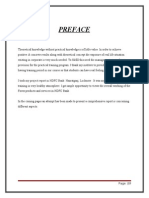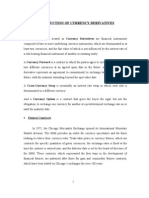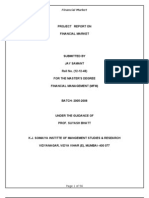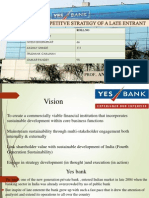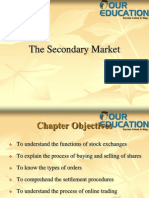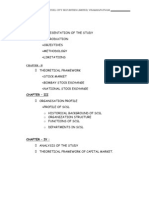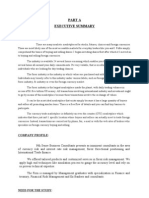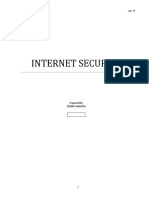0 ratings0% found this document useful (0 votes)
Grand Project
Grand Project
Uploaded by
Jemini GanatraThis document provides an overview of a master's level project report on measuring volatility in the Indian foreign exchange market. It includes a declaration by the two students, Kaushik Gangajaliya and Chandni Thakker, confirming the work is original. It also includes acknowledgments, an introduction on the foreign exchange market and derivatives, and outlines the research methodology that will be used in the analysis and interpretation section. The objectives are to analyze volatility in the Indian forex market and identify which currencies are most volatile.
Copyright:
© All Rights Reserved
Available Formats
Download as DOCX, PDF, TXT or read online from Scribd
Download as docx, pdf, or txt
Grand Project
Grand Project
Uploaded by
Jemini Ganatra0 ratings0% found this document useful (0 votes)
This document provides an overview of a master's level project report on measuring volatility in the Indian foreign exchange market. It includes a declaration by the two students, Kaushik Gangajaliya and Chandni Thakker, confirming the work is original. It also includes acknowledgments, an introduction on the foreign exchange market and derivatives, and outlines the research methodology that will be used in the analysis and interpretation section. The objectives are to analyze volatility in the Indian forex market and identify which currencies are most volatile.
Original Description:
this report contains information regarding variabilility in currency
Copyright
© © All Rights Reserved
Available Formats
DOCX, PDF, TXT or read online from Scribd
Share this document
Did you find this document useful?
Is this content inappropriate?
This document provides an overview of a master's level project report on measuring volatility in the Indian foreign exchange market. It includes a declaration by the two students, Kaushik Gangajaliya and Chandni Thakker, confirming the work is original. It also includes acknowledgments, an introduction on the foreign exchange market and derivatives, and outlines the research methodology that will be used in the analysis and interpretation section. The objectives are to analyze volatility in the Indian forex market and identify which currencies are most volatile.
Copyright:
© All Rights Reserved
Available Formats
Download as DOCX, PDF, TXT or read online from Scribd
Download as docx, pdf, or txt
0 ratings0% found this document useful (0 votes)
Grand Project
Grand Project
Uploaded by
Jemini GanatraThis document provides an overview of a master's level project report on measuring volatility in the Indian foreign exchange market. It includes a declaration by the two students, Kaushik Gangajaliya and Chandni Thakker, confirming the work is original. It also includes acknowledgments, an introduction on the foreign exchange market and derivatives, and outlines the research methodology that will be used in the analysis and interpretation section. The objectives are to analyze volatility in the Indian forex market and identify which currencies are most volatile.
Copyright:
© All Rights Reserved
Available Formats
Download as DOCX, PDF, TXT or read online from Scribd
Download as docx, pdf, or txt
You are on page 1/ 46
A
Master Level Project Report
On
Measuring the Volatility of Foreign Exchange Market in
India
Submitted
In the partial fulfillment of the Degree of
Master of Business Administration
Semester-4
Prepared By:-
Kaushik Gangajaliya (11SOMBA21059)
Chandni Thakker (11SOMBA21052)
Under the Guidance of:-
Dr. Chetna Parmar
(Associate Professor),
School of Management
Submitted To:
School of Management,
RK.University,
Rajkot.
Page | 2
DECLARATION
We hereby declare that project titled Measuring the Volatility of Foreign Exchange Market
in India. It is an original piece of research work carried out by us under the guidance and
supervision of Dr. Chetna Parmar. The Information has been collected from genuine and
authentic sources. The work has been submitted in the partial fulfillment of the requirement
of MBA to our college.
Signature: Name of the Students
Kaushik Gangajaliya
Chandni Thakker
Date:
Place: Rajkot
Page | 3
PREFACE
As a part of our course curriculum of MBA, We are assigned some practical studies as well
as the theoretical knowledge in the related areas for completing the project. We are preparing
comprehensive report on Measuring the Volatility of Foreign Exchange Market in India So
far as decision of the industry is concerned; we have chosen the financial industry. In our
project we are making use of secondary data for that purpose.
This project really enhances our knowledge about the Forex Market as a whole. This project
will also give us firm understanding of market behaviour and help to know which currency is
more volatile and in which one should invest in. We have gained lot knowledge from this
project. And we believe this will help us in near future.
Page | 4
ACKNOWLEDGEMENT
As a part of the MBA curriculum at R.K University, the Grand Project Report Program
enables the students to enhance their skills, expand their craniums by applying various
theories, concepts and laws to real life scenario which would further prepare them to face in
the near future.
Grand Project Report is the part of curriculum of R.K. University which helps in overall
development of the student and gives him or her platform to understand the corporate
environment as well as to implement the theoretical knowledge.
I would like to thank my faculty guide Dr. Chetna Parmar (associate Professor) for his
valuable guidance and support during my research period.
I would also like to thanks Dr. Raashid Saiyed, Director of school of management at R.K
University for giving me the opportunity to work in this research and carry the colleges
name forward.
Page | 5
Table of Content
Serial No. Particulars Page No.
1
Introduction
Industry
Regulatory Authorities/Laws
7
11
14
2
Need of the Study
Review of Literature
Research Gap
17
18
21
3
Research Design and Methodology
Objectives of Study
Hypothesis
Period of Study
Sample Design
Type of Research
Data Collection Method
Tools and Techniques for Data
Analysis
Limitations of Study
Future scope of study
22
23
24
24
25
26
27
27
28
28
4
Analysis and Interpretation
30
5
Conclusion
44
Page | 6
CHAPTER 1
Page | 7
Introduction to the Foreign Exchange Market
The foreign exchange market is the biggest financial market in the world. In forex market
everyday transactions is near about 3.98 trillion dollars. The major aim of introducing the
foreign exchange market is to facilitate international trade by enabling businesses to perform
transactions outside their local currency. The market operates round the clock from Monday
through Friday.
In the foreign exchange market a trader can purchase international currencies by paying
different currency. This type of foreign exchange market started to develop in the 1970s,
which was about thirty years after foreign exchange was introduced. Some important features
about the FX market include the following:
1. It has a very large number of daily participants. This makes its liquidity one of the
highest in the world.
2. Participants come from several countries in the world.
3. The market is open from 22:00 GMT on Sunday to 20:00 GMT on Friday.
4. Exchange rates are affected by a number of factors.
Market Size and Liquidity
Liquidity in the forex market is the highest among other financial markets in the world. The
market comprises central banks, currency speculators, organizations, governments, retail
investors and international investors. Over the years, the size of the FX market has been
constantly increasing. In 2010, The Triennial Survey by the Bank of International
Settlements reported that the average daily transaction in the US for the month of April was
$3.98 trillion. This was much greater than the $1.7 trillion recorded in 1998.
Page | 8
Market Participant
There are three types of participants in the foreign exchange market. These are: central
banks, global funds, retail clients (or individual retailers) and corporations. The commercial
and investment banks belong to the group known as interbank market. This level
constitutes about seventy five percent of the total volume available each day.
Determinants of FX rates
For countries operating on the floating exchange rate regime, the exchange rates of their
currencies can be determined by the following theories:
1. International Parity Conditions: These include theories such as relative purchasing
power parity, interest rate parity, domestic fisher effect and international fisher effect.
Although these theories work to actually determine FX rates, they can also falter
because they are formed on assumptions that are not always true.
2. Balance of payment model: This is concerned with the exchange of goods and
services without considering the effect of the flow of money between and among
nations.
It is not possible to predict FX rates within long time frames with these theories. The best
that can be done with these is predicting future prices that can occur within a few days. FX
rates cannot be judged on a single factor but rather by combining several factors in
economics, politics and market psychology.
Page | 9
Meaning of 'Derivative'
A security whose price is dependent upon or derived from one or more underlying assets.
The derivative itself is merely a contract between two or more parties. Its value is determined
by fluctuations in the underlying asset. The most common underlying assets include stocks,
bonds, commodities, currencies, interest rates and market indexes. Most derivatives are
characterized by high leverage.
Meaning of Currency Derivative
Futures Contract is a standardized exchange traded contract to buy or sell a certain
underlying instrument at a certain date in the future at a specified price. The underlying
instrument in Currency future is a foreign exchange rate. The price of a future contract is
expressed in terms of INR per unit of other currency e.g. US Dollars. Currency future
contracts allow investors to hedge against foreign exchange risk. Currently Currency Futures
are available on four currency pairs viz. US Dollars (USD-INR), Euro (EUR-INR), Great
Britain Pound (GBP-INR) and Japanese Yen (JPY-INR).
Benefits of Currency Derivative
Currency Derivatives are very efficient risk management instruments and you can derive the
below benefits:
1. Hedging: You can protect your foreign exchange exposure in business and hedge
potential losses by taking appropriate positions in the same. For e.g. If you are an
importer, and have USD payments to make at a future date, you can hedge your
foreign exchange exposure by buying USDINR and fixing your pay out rate today.
You would hedge if you were of the view that USDINR was going to depreciate.
Similarly it would give hedging opportunities to Exporters to hedge their future
receivables,
2. Speculation: You can speculate on the short term movement of the markets by using
Currency Futures. For e.g. If you expect oil prices to rise and impact India's import
bill, you would buy USDINR in expectation that the INR would depreciate.
Page | 10
Alternatively if you believed that strong exports from the IT sector, combined with
strong FII flows will translate to INR appreciation you would sell USDINR.
3. Arbitrage: You can make profits by taking advantage of the exchange rates of the
currency in different markets and different exchanges.
4. Leverage: You can trade in the currency derivatives by just paying a % value called
the margin amount instead of the full traded value.
Financial Instruments
Financial instruments in the Forex market include spot, forward and swap.
Spot
A spot transaction lasts for two days except when currencies such as the US dollar, Canadian
dollar, Euro, Turkish Lira and Russian ruble are traded. In these cases, transactions are
completed on the next business day. Normally, there is no interest involved in this transaction
since it is just a direct exchange.
Forward
Forward transaction is an effective way of reducing risks in the Forex market. With this,
traders do not exchange money until when an agreed exchange rate between currencies is
actualized. This may happen in one day, several months or years.
Swap
In swap, two traders agree to make a transaction that will be reversed in the future. Since this
is not a standard operation, there is no exchange created for this.
Page | 11
HISTORY OF FOREIGN EXCHANGE MARKET
Ancient
Forex first occurred in ancient times. Money-changing people, people helping others to
change money and also taking a commission or charging a fee were living in the times of the
Talmudic writings (Biblical times). These people (sometimes called "kollybists") used city-
stalls, at feast times the temples Court of the Gentiles instead. The money-changer was also
in more recent ancient times silver-smiths and, or, gold-smiths.
Medieval and later
During the fifteenth century the Medici families were required to open banks at foreign
locations in order to exchange currencies to act for textile merchants. During the 17
th
(or 18
th
)
century Amsterdam maintained an active forex market. During 1704 foreign exchange took
place between agents acting in the interests of the nations of England and Holland.
Early modern
During 1880 J.M. do Esprito Santo de Silva (Banco Esprito e Comercial de Lisboa) applied
for and was given permission to begin to engage in a foreign exchange trading business. 1880
is considered by one source to be the beginning of modern foreign exchange, significant for
the fact of the beginning of the gold standard during the year.
Modern to post-modern
Before WWI I
At the time of the closing of the year 1913, nearly half of the world's forexes were being
performed using sterling. In 1902 there were altogether two London foreign exchange
brokers. In the earliest years of the twentieth century trade was most active in Paris, New
York and Berlin, while Britain remained largely uninvolved in trade until 1914.
Page | 12
After WWI I
After WWII the Bretton Woods Accord was signed allowing currencies to fluctuate within a
range of 1% to the currencies par. In Japan the law was changed during 1954 by the Foreign
Exchange Bank Law, so, the Bank of Tokyo was to become because of this the centre of
foreign exchange by September of that year.
After 1973
In fact 1973 marks the point to which nation-state, banking trade and controlled foreign
exchange ended and complete floating, relatively free conditions of a market characteristic of
the situation in contemporary times began (according to one source), although another states
the first time a currency pair were given as an option for U.S.A. traders to purchase was
during 1982, with additional currencies available by the next year.
On 1 January 1981 the Bank of China allowed certain domestic "enterprises" to participate in
foreign exchange trading. Sometime during the months of 1981 the South Korean
government ended forex controls and allowed free trade to occur for the first time. During
1988 the countries government accepted the IMF quota for international trade.
According to the Bank for International Settlements, as of April 2010, average daily turnover
in global foreign exchange markets is estimated at $3.98 trillion, a growth of approximately
20% over the $3.21 trillion daily volume as of April 2007. Some firms specializing on
foreign exchange market had put the average daily turnover in excess of US$4 trillion.
The $3.98 trillion break-down is as follows:
Particulars Amount In $
Spot transations 1.490 trillion
Outright forwards $475 billion
Foreign exchange swaps 1.765 trillion
Currency swaps 43 billion
Options and other products 207 billion
Page | 13
HISTORY OF FOREIGN EXCHANGE MARKET WITH REFRENCE TO
INDIAN CAPITAL MARKET
The forex trading history of India dates back to 1978, when reserve bank of India took a step
towards allowing the banks to undertake intra-day trading in foreign exchange. It is during
the period of 1975-1992 when reserve bank of India, officially determined the exchange rate
of rupee according to the weighted basket of currencies with the significant business partners
of India. But it needs to be mentioned that there are too many restrictions on these banks
during this period for trading in the forex market.
The introduction of the open market policy in the year 1991 and implementation of the new
economic policy by the govt. of India brought a comprehensive change in the Forex market
of India. It is during the month of July 1991, that the rupee undergone a twofold downward
adjustment and this was in line with inflation differential to ensure competitiveness in
exports. Then as per the recommendation of a high level committee set up to review the
balance of payment position, the liberalized exchange rate management system or the lerms
was introduced in 1992. The method of dual exchange rate mechanism that was part of the
terms also came into effect 1993. It is during this time that uniform exchange rate came into
effect and that started demand and supply controlled exchange rate regime in Indian.
It was the report and recommendations of the expert group on foreign exchange, formed to
judge the forex market in India that actually helped to widen the forex trading practices in the
country. As per the recommendations of the expert committee, reserve bank of India and the
government took so many significant steps that ultimately gave freedom to the banks in many
ways. Apart from the banks corporate bodies were also given certain relaxation that also
played an instrumental role in spread of forex trading in India.
It is during the year 2008 that Indian forex market has seen a great advancement that took the
Indian forex trading at par with the global forex markets. it is the introduction of future
derivative segment in forex trading through the national stock exchange (NSE) and MCX
stock exchange (MCX-SX). this step not only increased the Indian forex market volume too
Page | 14
many folds also gave the individual and retail investor a chance to trade at the forex market,
that was till this time remained a forte of the banks and large corporate.
Indian forex market got yet another boost recently when the SEBI and Reserve bank of India
permitted the trade of derivative contract at the leading stock exchanges NSE and MCX for
three new currency pairs. In its recent circulars reserve bank of India accepting the proposal
of SEBI, permitted the trade of INR-GBP (Indian rupee and Great Britain pound), INR-EUR
(Indian rupee and Euro) and INR-YEN (Indian rupee and Japanese yen). This was in addition
with the existing pair of currencies that is US$ and INR. From inclusion of these three
currency pairs in the Indian forex circuit the Indian forex scene is expected to boost even
further as these are some of the most widely traded currency pairs in the world.
REGULATORY AUTORITIES
The role of financial regulatory bodies or agencies is to control the financial markets by
making the regulations and to see that are followed by the financial companies. These
regulations are meant to have proper processes for smooth running and to avoid the scams
and unethical practices to protect the investors. These regulatory agencies are country or
economic zone dependent and could be governmental or independent. To protect the
investments it is important to check whether the regulatory status of the broker in your
country.
International organizations:
EU Commission
Ernst & Young (E&Y)
Financial Markets Association (ACI)
KPMG
Page | 15
Regulatory Authorities of major countries
Country Regulatory
India
Securities And Exchange Board Of India SEBI
Reserve Bank Of India RBI
Australia
Australian Securities and Investment Commission (ASIC)
International Financial Services Commission (IFSC)
Canada
British Columbia Securities Commission (BCSC)
Canadian Investor Protection Fund (CIPF)
Financial Transactions and Reports Analysis Center of Canada (FINTRAC)
Investment Industry Regulatory Organization of Canada (IIROC)
Ontario Securities Commission (OSC)
Dubai, UAE
Dubai Multi Commodities Centre (DMCC)
Dubai Gold & Commodities Exchange (DGCX)
Dubai Financial Services Authority (DFSA)
Emirates Securities and Commodities Authority (SCA)
United States
Commodities and Futures Trading Commission (CFTC)
Financial Industry Regulatory Authority (FINRA)
National Futures Association (NFA)
New York Stock Exchange (NYSE)
Office of the Comptroller of the Currency (OCC)
US Securities and Exchanges Commission (U.S. SEC)
Chicago Board of Trade (CBOT)
Securities Investor Protection Corporation (SIPC)
Russia
FFMS in Russia (FCFR)
France
Autorite des marches financiers (AMF)
Page | 16
CHAPTER 2
Page | 17
NEED OF THE STUDY
Till date there has not been any perfect model to predict the volatility present in the
Forex market because of the interdependent factors increasing the complexity of the Forex
market. There is immense need to manage the risk effectively and efficiently. Going through
the vast literature on this topic, we found
1. To measure the volatility of various currencies like GBP-INR, JPY-INR, USD-INR,
EURO-INR.
2. The need to identify which Currency is more volatile.
Page | 18
REVIEW OF LITERATURE
1. Bekaert (1995) analyzes the time variation in conditional means and variances of
monthly and quarterly excess dollar returns on Eurocurrency investments. All results
are based on a vector auto regression with weekly sampled data on exchange rate
changes and forward premiums of three currencies. Both past exchange rate changes
and forward premiums predict future forward market returns. Moreover, past forward
premium volatilities predict the volatility of exchange rates.
2. Bertram (2006) says that the second order properties of financial data, such as
volatility and correlation, have been the focus many recent studies investigating the
presence of long-memory, power-law tails, non-stationary and scaling behavior in
financial data. It is becoming increasingly apparent from these studies that time
dependence and non-stationary are major features of financial data.
3. Johnson (2002) introduced a model to explore the connection between realized
trends and changes in volatility. Foreign exchange returns exhibit the surprising and
consistent property that volatility increases when trends continue and decreases when
they reverse. Equivalently, the volatility spot covariance, and hence finite-horizon
skewness, behaves like a lagged momentum indicator.
4. Vergni and Vulpiani (1999) have shown the presence of long term anomalies
like the structure functions and a generalization of the usual correlation analysis in the
foreign exchange market. They say that the available information strongly depends on
the kind of investment the speculator has in mind.
5. Zumbach (2002) introduces a new family of processes that include the long
memory (power law) in the volatility correlation. This is achieved by measuring the
historical volatility on a set of increasing time horizons and by computing the
resulting effective volatility by a sum with power law weights.
Page | 19
6. Hodrick (1992, 1993) deduced that the vector auto regressive approach as several
advantages over the by-now standard method of using overlapping high-frequency
data on monthly or quarterly variable estimates of the conditional variance of monthly
and quarterly forward-market returns. It is well known that the forward rate is not an
unbiased predictor of the future spot rate. One implication of the vast literature on the
subject is that returns from investing in the forward market are predictable by the
forward premium as shown in the research work of Bekaert.
7. Solano (2004) says that modeling the unconditional distribution of returns on
exchange rate and measuring its tails area are issues in the finance literature that have
been studied extensively by parametric and non-parametric estimation procedures.
However, a conflict of robustness is derived from them because the time series
involved in this process are usually fat tailed and highly peaked around the center.
8. Figlewaski (1981) argued that speculation in the derivatives market is transmitted
to the underlying spot markets. The speculation produces a net loss with some
speculators gaining (and others loosing), thereby destabilize the market. Uninformed
speculative traders increase price volatility by interjecting noise to a market with
limited liquidity. The inflow and existence of the speculators in the derivatives
market produces destabilization forces, which creates undesirable bubbles.
9. Clifton (1985) found a strong positive correlation between futures trading and
exchange rate volatility measured by the spread between the daily high and low
exchange rates for Deutsche marks, Swiss franc, Canadian dollars, and Japanese yen.
Grammatikos and Saunders (1986) investigated British pound, Canadian dollar,
Japanese yen, Swiss franc and Deutsche mark foreign currency futures traded on the
International Monetary Market over the period of 1978-1983 and found that there
exists a bidirectional causal relationship between volume and price variability in
futures market transactions.
Page | 20
10. Kumar and Seppi (1992) and Jarrow (1992) studied the impact of currency
derivatives on spot market volatility and found that speculative trading executed by
big players in the derivatives market increases the volatility in the spot exchange rate.
Hence, currency futures trading increases the spot market volatility.
Page | 21
RESEARCH GAP
Most of the research paper includes the research done on volatility between the currency pair
INR and USD for the Indian foreign exchange market. There are very less number of
research done on other currencies like Euro, British Pound, Yen, etc with the Indian rupee.
This signifies that the most common currency used to measure volatility with INR is US
Dollars.
Our Research would include the measure of volatility with 4 currencies:-
1. INR- USD
2. INR- EURO
3. INR-GBP
4. INR- JPY
Page | 22
CHAPTER 3
Page | 23
RESEARCH METHODOLOGY
Research methodology is a way to systematically solve the research problem. It may be
understood as a science of studying how research is done scientifically. It is necessary for the
researcher to know not only the research methods/techniques but also methodology.
Researchers not only need to know how to develop certain indices or tests, how to calculate
the mean, the mode, the median or the standard deviation or chi square, how to apply
particular research techniques, but they also need to know which of these methods or
techniques are relevant or not, and what they mean and indicate and why. Researchers also
need to understand the assumptions underlying various techniques and they need to know the
criteria by which they can decide that certain techniques and procedures will be applicable to
certain problems.
Hence, when we talk of research methodology we not only talk about research methods but
also consider the logic behind the methods we use in context of our research study and
explain why we are using a particular method or technique and why we are not using others
so that research results are capable of being evaluated either by the researcher himself or by
others.
A. Objective of the study
To find out the volatility of four major currencies i.e.US Dollar, EURO, Britain
Pound and Japanese Yen that traded mostly in world and has allowed trading in
Indian Forex market
To measure the volatility distribution in these four currencies in Indian FOREX
market.
Page | 24
B. Hypothesis of this study
Hypothesis is being tested for 5 percent of significance level.
1. Ho: There is not significance difference on volatility of selected currency in Forex
market.
2. Ha: There is significance difference on volatility of selected currency in Forex
market.
Sub parameter of the Hypothesis:-
1. USD-INR (Bid, Ask, Mid)
2. JPY-INR (Bid, Ask, Mid)
3. EURO-INR (Bid, Ask, Mid)
4. GBP-INR (Bid, Ask, Mid)
C. Period of the Study
This will define how much time we will take to complete this research work which is
related to volatility in Indian Forex market.
Here we have estimated that it will take 45 days to carry out research work along with
academic term.
Page | 25
D. Sample Design
Sample Universe
The sampling universe is the total number of items/events from which you can select
or sample for statistical analysis and description. There are almost 182 different
currencies in the world.
Common Currencies traded in the FX Market.
Currency Name Symbol
US Dollar USD
Pound GBP
Swiss Franc CHF
Japanese Yen JPY
Canadian Dollar CAD
Euro EUR
Australian Dollar AUD
New Zealand Dollar NZD
Sample Unit
Sample Unit are the constituents of the elements i.e. the number of currencies
in our research. In our research we have taken 4 currencies to measure
volatility with Indian rupees. The 4 currencies in our research includes:-
1. USD- US Dollars
2. EUR- EURO
3. GBP- German British Pound
4. JPY- Japanese Yen
Page | 26
Sample Period
Sample Period means the time taken of the sample in the research for
measuring the volatility. Here, in our research we have taken the secondary
data of past two years of the volatility. The 2 years i.e. 24 months include:-
- 1
st
January 2011 to 31
st
December 2011 (12 months)
- 1
st
January 2012 to 31
st
December 2012 (12 months)
E. Type of Research
We have used secondary data in our project so we have followed historical method of
collecting the information. There are 2 types of research:
1. Qualitative research
Qualitative research is a method of inquiry employed in many different
academic disciplines, traditionally in the social sciences, but also in market research
and further contexts. Qualitative researchers aim to gather an in-depth understanding
of human behavior and the reasons that govern such behavior. The qualitative method
investigates the why and how of decision making, not just what, where, when. Hence,
smaller but focused samples are more often needed than large samples.
2. Quantitative research
Quantitative research refers to the systematic empirical investigation of social
phenomena via statistical, mathematical or computational techniques. The objective
of quantitative research is to develop and employ mathematical models, theories
and/or hypotheses pertaining to phenomena. The process of measurement is central to
quantitative research because it provides the fundamental connection between
empirical observation and mathematical expression of quantitative relationships.
Our project includes the quantitative research because we have taken historical data
and carried out research based on the statistical data and other mathematical
information.
Page | 27
F. Data Collection
There are two sources of data i.e.
1. Primary data
2. Secondary data
Primary data collection uses surveys, experiments or direct observations.
Secondary data collection may be conducted by collecting information from a
diverse source of documents or electronically stored information.
Here we have used Secondary data, like currency rates and all other
information are collected through referring websites and different research paper.
G. Tools and Techniques for Data Analysis
Here we find the Skewness and Kurtosis with the help of descriptive statistics tool, of
the given currencies to find volatility with the help of some tools like standard deviation and
the variance of the market.
Here we will use JARQUE - BERA TEST. The Jarque-Bera test is used to check
hypothesis about the fact that a given sample .x^ is a sample of normal random variable with
unknown mean and dispersion. As a rule, this test is applied before using methods of
parametric statistics which require distribution normality.
Page | 28
H. Limitation of the Study
Exchange rate currencies chosen for the above study is based not on the importance
of the currency but on the volumes traded in the foreign exchange market in whole
world. And are mainly allowed in India.
Sometimes it happens that the finding of volatility may not help the investor to take
decision for choosing best investment plan
I. Future scope of the study
This research will help to know the impact of the behavior of Foreign Exchange rate
Indian forex market.
It will help to find out which currency is having more volatility in Indian forex
market.
It will also help to know whether Indian forex market is much stable or not.
This research will help the Investor to decide in which currency to invest on the basis
of the volatility of the particular currency.
The investor expecting high return will invest in highly volatile currency and investor
wanting less risk will invest with low volatile currency.
Page | 29
CHAPTER 4
Page | 30
Analysis and Interpretation
Descriptive Statistics
Descriptive statistics are used to describe the basic features of the data in a study. They
provide simple summaries about the sample and the measures. Together with simple graphics
analysis, they form the basis of virtually every quantitative analysis of data.
Descriptive Statistics are used to present quantitative descriptions in a manageable form. In a
research study we may have lots of measures. Or we may measure a large number of people
on any measure. Descriptive statistics help us to simply large amounts of data in a sensible
way.
Volatility is a measure of how far the current prices of an asset deviate from its average past
prices. Here we measure volatility in Forex market for USD, EURO and YEN by measuring
the mean and the variance in logarithm of change in their daily exchange rate. The greater the
deviation, the greater is the volatility. Volatility can indicate the strength or conviction
behind the price move.
Skewness quantifies how symmetrical the distribution is. A distribution that is symmetrical
has a skewness of 0. If the skewness is positive, that means the right tail is 'heavier' than the
left tail. If the skewness is negative, then the left tail of the distribution is dominant.
Kurtosis quantifies whether the shape of the data distribution matches the Gaussian
distribution. A Gaussian distribution has a kurtosis of 0. A flatter distribution has a negative
kurtosis, and a more peaked distribution has a positive kurtosis. It is sometimes referred to as
the "volatility of volatility."
JARQUE - BERA - The Jarque-Bera test is used to check hypothesis about the fact that a
given sample x^ is a sample of normal random variable with unknown mean and dispersion.
As a rule, this test is applied before using methods of parametric statistics which require
distribution normality. This test is based on the fact that skewness and kurtosis of normal
distribution equal zero. Therefore, the absolute value of these parameters could be a measure
of deviation of the distribution from normal. Using the sample Jarque-Bera statistic is
Page | 31
calculated: (There n is a size of sample), then p-value is computed using a table of
distribution quantiles.
CROSS RATES OF USD/INR
End Date USD/INR BID USD/INR ASK USD/INR MID
12/31/2012 54.5574 54.7223 54.6399
11/30/2012 54.6891 54.8492 54.7691
10/31/2012 52.8582 53.0416 52.9499
9/30/2012 54.2308 54.4129 54.3219
8/31/2012 55.3555 55.5268 55.4412
7/31/2012 55.1853 55.4268 55.306
6/30/2012 55.8476 56.2372 56.0424
5/31/2012 54.4692 54.8616 54.6654
4/30/2012 52.1835 52.6278 52.4056
3/31/2012 50.6989 51.1297 50.9143
2/29/2012 49.4113 49.7803 49.5958
1/31/2012 51.909 52.3554 52.1322
12/31/2011 53.0675 53.4738 53.2707
11/30/2011 50.7983 51.1129 50.9556
10/31/2011 49.5209 49.9493 49.7351
9/30/2011 47.6179 48.0485 47.8332
8/31/2011 45.2809 45.6663 45.4736
7/31/2011 44.556 44.9391 44.7475
6/30/2011 45.1789 45.5486 45.3638
5/31/2011 44.882 45.2983 45.0901
4/30/2011 44.6238 44.9972 44.8105
3/31/2011 45.3763 45.7102 45.5433
2/28/2011 45.5144 45.8936 45.704
1/31/2011 45.6407 46.0777 45.8592
Page | 32
USD/INR ANALYSIS
Particulars Bid Rates Ask Rates Mid Rates
Mean 50.1438 50.4869 50.3154
Standard Error 0.8448 0.8343 0.8395
Standard Deviation 4.1389 4.0874 4.1129
Sample Variance 17.1310 16.7073 16.9167
Kurtosis -1.6462 -1.6403 -1.6436
Skewness -0.1322 -0.1478 -0.1402
Sum 1203.4534 1211.6871 1207.5703
Count 24 24 24
JB TEST (Calculated value)
0
10
20
30
40
50
60
R
a
t
e
Axis Title
USD/INR BID
USD/INR Ask
USD/INR MID
Page | 33
Bid 21.65754
Ask 21.62065
Mid 21.64225
BID ASK MID
Period Average 50.1439 50.487 50.3154
Period Low 44.556 44.9391 44.7475
Period High 55.8476 56.2372 56.0424
Analysis and Interpretation:
Skewness and kurtosis values for monthly in USD/INR exchange return suggest that it far
from the normal distribution which ideally should be 0 in case of normal distribution. So
researcher found that there is high volatility and volatility also affected funds flow in
international market.
The above table shows difference on average, low and high of Bid, Ask and Mid rates on
USD/INR. Here table also indicated that Bid had same difference (Low and High) but more
difference realized on Ask and Mid. Currency market was continuous fluctuating as per
demand and supply of that particular currency.
The value of Jarque Bera = 21.65 is clearly greater than the critical value of 5.99 for 95% for
a =.05 for 2 degrees of freedom obtained from Chi Square Distribution Table. This means
that (.he null hypothesis that the there is no significance difference on volatility of USD/INR
is normally distributed for the time period between 2011 to 2012 is rejected for the given
confidence interval of 95% and we accept the alternate hypothesis that the returns of
USD/INR have significance difference on volatility of USD/INR.
Page | 34
CROSS RATES OF GBP/INR
End Date GBP/INR BID GBP/INR ASK GBP/INR MID
12/31/2012 87.9721 88.26 88.116
11/30/2012 87.3088 87.5801 87.4445
10/31/2012 84.9799 85.2911 85.1355
9/30/2012 87.2486 87.5594 87.404
8/31/2012 86.939 87.2243 87.0816
7/31/2012 86.0822 86.4788 86.2805
6/30/2012 86.7943 87.424 87.1091
5/31/2012 86.8622 87.5108 87.1865
4/30/2012 83.4875 84.2248 83.8561
3/31/2012 80.2152 80.9182 80.5667
2/29/2012 78.0526 78.6579 78.3552
1/31/2012 80.4665 81.1859 80.8262
12/31/2011 82.7636 83.4216 83.0926
11/30/2011 80.3799 80.9005 80.6402
10/31/2011 78.0035 78.7053 78.3544
9/30/2011 75.3122 76.0147 75.6634
8/31/2011 74.116 74.7737 74.4448
7/31/2011 71.9209 72.5623 72.2416
6/30/2011 73.3178 73.9387 73.6283
5/31/2011 73.4054 74.1115 73.7585
4/30/2011 72.9435 73.5774 73.2605
3/31/2011 73.3336 73.893 73.6133
2/28/2011 73.3482 73.9809 73.6646
1/31/2011 71.9096 72.6218 72.2657
Page | 35
GBP/INR ANALYSIS
Particulars Bid Rates Ask Rates Mid Rates
Mean 79.8817 50.4869 50.3154
Standard Error 1.2145 0.8343 0.8395
Standard Deviation 5.9501 4.0874 4.1129
Sample Variance 35.4046 16.7073 16.9167
Kurtosis -1.6775 -1.6403 -1.6436
Skewness 0.0098 -0.1478 -0.14028
Sum 1917.1631 1211.6871 1207.5703
Count 24 24 24
JB TEST (Calculated value)
0
10
20
30
40
50
60
70
80
90
100
A
x
i
s
T
i
t
l
e
Axis Title
GBP/INR BID
GBP/INR ASK
GBP/INR MID
Page | 36
Bid 21.87921
Ask 21.62065
Mid 21.64225
BID ASK MID
Period Average 79.8818 80.4507 80.1662
Period Low 71.9096 72.5623 72.2416
Period High 87.9721 88.26 88.116
Analysis and Interpretation:
Skewness and kurtosis values for monthly in GBP/INR exchange return suggest that it is far
from the normal distribution which ideally should be 0 in case of normal distribution. So
researcher found that there is high volatility and volatility also affected funds flow in
international market.
The above table shows difference on average, low and high of Bid, Ask and Mid rates on
GBP/INR. Here table also indicated that Bid had same difference (Low and High) but more
difference realized on Ask and Mid.
The value of Jarque Bera = 21.87 is clearly greater than the critical value of 5.99 for 95% for
a = .05 for 2 degrees of freedom obtained from Chi Square Distribution Table. This means
that (.he null hypothesis that the there is no significance difference on volatility of GBP/INR
is normally distributed for the time period between 2011 to 2012 is rejected for the given
confidence interval of 95% and we accept the alternate hypothesis that the returns of
GBP/INR have significance difference on volatility of GBP/INR.
Page | 37
CROSS RATES OF EURO/INR
End Date EUR/INR BID EUR/INR ASK EUR/INR MID
12/31/2012 71.501 71.7296 71.6153
11/30/2012 70.1525 70.37 70.2612
10/31/2012 68.5494 68.7995 68.6744
9/30/2012 69.6926 69.9394 69.816
8/31/2012 68.551 68.7752 68.6631
7/31/2012 67.9225 68.2372 68.0798
6/30/2012 69.9972 70.5086 70.2529
5/31/2012 69.9146 70.4396 70.1771
4/30/2012 68.718 69.3276 69.0228
3/31/2012 66.9831 67.57 67.2766
2/29/2012 65.3215 65.8295 65.5755
1/31/2012 66.9152 67.5137 67.2145
12/31/2011 69.9451 70.5009 70.223
11/30/2011 68.998 69.4442 69.2211
10/31/2011 67.8428 68.4517 68.1473
9/30/2011 65.6981 66.3109 66.0045
8/31/2011 64.9458 65.522 65.2339
7/31/2011 63.7411 64.3087 64.0249
6/30/2011 64.974 65.5222 65.2481
5/31/2011 64.3583 64.974 64.6662
4/30/2011 64.4152 64.9726 64.6939
3/31/2011 63.5298 64.0134 63.7716
2/28/2011 62.1063 62.6408 62.3736
1/31/2011 60.9479 61.5512 61.2496
Page | 38
EURO/INR ANALYSIS
Particulars Bid Ask Mid
Mean 66.9050 67.3855 67.1452
Standard Error 0.5811 0.5654 0.5731
Standard Deviation 2.8470 2.7700 2.8079
Sample Variance 8.1059 7.6733 7.8843
Kurtosis -0.8051 -0.7696 -0.7878
Skewness -0.3712 -0.4041 -0.3885
Sum 1605.721 1617.2525 1611.4869
Count 24 24 24
JB TEST (Calculated value)
54
56
58
60
62
64
66
68
70
72
A
x
i
s
T
i
t
l
e
Axis Title
EUR/INR BID
EUR/INR ASK
EUR/INR MID
Page | 39
Bid 15.03033
Ask 14.86317
Mid 14.95185
Analysis and Interpretation:
Skewness and kurtosis values for monthly in EUR/INR exchange return suggest that it is far
from the normal distribution which ideally should be 0 in case of normal distribution. So
researcher found that there is high volatility and volatility also affected funds flow in
international market.
The above table shows difference on average, low and high of Bid, Ask and Mid rates on
EUR/INR. Here table also indicated that Bid had same difference (Low and High) but more
difference realized on Ask and Mid. Currency market was continuous fluctuating as per
demand and supply of that particular currency.
The value of Jarque Bera = 15.03 is clearly greater than the critical value of 5.99 for 95% for
a = .05 for 2 degrees of freedom obtained from Chi Square Distribution Table. This means
that (.he null hypothesis that the there is no significance difference on volatility of EUR/INR
is normally distributed for the time period between 2011 to 2012 is rejected for the given
confidence interval of 95% and we accept the alternate hypothesis that the returns of
EUR/INR have significance difference on volatility of EUR/INR.
BID ASK MID
Period Average 66.9051 67.3855 67.1453
Period Low 60.9479 61.5512 61.2496
Period High 71.501 71.7296 71.6153
Page | 40
1. CROSS RATES OF JPY/INR
End Date JPY/INR BID JPY/INR ASK JPY/INR MID
12/31/2012 0.6524 0.6545 0.6534
11/30/2012 0.6763 0.6784 0.6773
10/31/2012 0.6697 0.6722 0.6709
9/30/2012 0.6934 0.6959 0.6946
8/31/2012 0.7035 0.7058 0.7046
7/31/2012 0.698 0.7012 0.6996
6/30/2012 0.7047 0.7099 0.7073
5/31/2012 0.6829 0.6882 0.6855
4/30/2012 0.6408 0.6466 0.6437
3/31/2012 0.615 0.6204 0.6177
2/29/2012 0.6305 0.6355 0.633
1/31/2012 0.6744 0.6805 0.6774
12/31/2011 0.6816 0.6871 0.6843
11/30/2011 0.6552 0.6596 0.6574
10/31/2011 0.6462 0.6521 0.6491
9/30/2011 0.6196 0.6255 0.6226
8/31/2011 0.5874 0.5928 0.5901
7/31/2011 0.5608 0.5659 0.5634
6/30/2011 0.5615 0.5663 0.5639
5/31/2011 0.5533 0.5587 0.556
4/30/2011 0.5357 0.5405 0.5381
3/31/2011 0.5558 0.5602 0.558
2/28/2011 0.5509 0.5557 0.5533
1/31/2011 0.553 0.5586 0.5558
Page | 41
JPY/INR
Particulars Bid Ask Mid
Mean 0.6292 0.6338 0.6315
Standard Error 0.0117 0.0116 0.0117
Standard Deviation 0.0576 0.0571 0.0573
Sample Variance 0.0033 0.0033 0.0033
Kurtosis -1.4525 -1.4420 -1.4469
Skewness -0.3141 -0.3267 -0.3208
Sum 15.1026 15.2121 15.157
Count 24 24 24
JB TEST (Calculated value)
0
0.1
0.2
0.3
0.4
0.5
0.6
0.7
0.8
A
x
i
s
T
i
t
l
e
Axis Title
JPY/INR BID
JPY/INR ASK
JPY/INR MID
Page | 42
Bid 20.22027
Ask 20.15916
Mid 20.18694
BID ASK MID
Period Average 0.6293 0.6338 0.6316
Period Low 0.5357 0.5405 0.5381
Period High 0.7047 0.7099 0.7073
Analysis and Interpretation:
Skewness and kurtosis values for monthly in JPY/INR exchange return suggest that it is far
from the normal distribution which ideally should be 0 in case of normal distribution. So
researcher found that there is high volatility and volatility also affected funds flow in
international market.
The above table shows difference on average, low and high of Bid, Ask and Mid rates on
JPY/INR. Here table also indicated that Bid had same difference (Low and High) but more
difference realized on Ask and Mid. Currency market was continuous fluctuating as per
demand and supply of that particular currency
The value of Jarque Bera = 20.22 is clearly greater than the critical value of 5.99 for 95% for
a = .05 for 2 degrees of freedom obtained from Chi Square Distribution Table. This means
that (.he null hypothesis that the there is no significance difference on volatility of JPY/INR
is normally distributed for the time period between 2011 to 2012 is rejected for the given
confidence interval of 95% and we accept the alternate hypothesis that the returns of
USD/INR have significance difference on volatility of JPY/INR.
Page | 43
CHAPTER 5
Page | 44
Conclusion
Here in our Research we can conclude that our primary hypothesis i.e. there is no
significance difference on volatility of selected currency in Forex market, is rejected and our
alternate Hypothesis i.e. There is significance difference on volatility of selected currency in
Forex market, is accepted. Means we can say that all Four Currency having significant
volatility.
We have observed more volatility in EUR/INR pair as it Kurtosis value is higher than other
three pairs. For all the four currencies under this study, we find generally an increasing trend
in volatility.
Page | 45
BIBLIOGRAPHY
Page | 46
Website: -
www.ibfx.com
http://www.ibfx.com/Trade/The-Foreign-Exchange-Market
en.wikipedia.org
http://en.wikipedia.org/wiki/Foreign_exchange_market
www.forexabode.com
http://www.forexabode.com/forex-regulatory-bodies
www.sharetipsinfo.com
http://www.sharetipsinfo.com/global-forex-market-india.html
www.invesopedia.com
en.wikipedia.org
www.oanda.com
http://www.oanda.com/currency/historical-rates/
Research Paper:-
1. RBI Working paper Series WPS (DEPR): 1/2011
Title:- An Empirical Analysis of the Relationship Between Currency Futures And
Exchange Rates Volatility In India
By-Somnath Sharma
2. Research Journal of Finance and Accounting.
ISSN 2222-1697 (Paper) ISSN 2222-2847 (Online)
Vol 2, No 9/10, 2011
Title: - Measuring the Volatility of Foreign Exchange Market in India
By:- Neeti Khullar
Upasna Joshi Sethi
Books:-
Research Methodology-Methods and Techniques
-Second Edition
-By C. R. Kothari
You might also like
- Financial Servises Provided by Anand RathiNo ratings yetFinancial Servises Provided by Anand Rathi48 pages
- Derivatives: The Important Categories of DerivativesNo ratings yetDerivatives: The Important Categories of Derivatives10 pages
- Analyzing Forex Exposure of Infosys: CIA-1 OF International Financial ManagementNo ratings yetAnalyzing Forex Exposure of Infosys: CIA-1 OF International Financial Management12 pages
- An Impact of Currency Fluctuations On Indian Stock MarketNo ratings yetAn Impact of Currency Fluctuations On Indian Stock Market6 pages
- Submitted in Partial Fulfillment of The Requirements For Master of Business AdministrationNo ratings yetSubmitted in Partial Fulfillment of The Requirements For Master of Business Administration68 pages
- Regulatory Framework of Commodity FutureNo ratings yetRegulatory Framework of Commodity Future38 pages
- Prestige Institute of Management & Research, Indore: "Analysis of Stock Market at Arihant Capital"No ratings yetPrestige Institute of Management & Research, Indore: "Analysis of Stock Market at Arihant Capital"27 pages
- A Summer Internship Project Report On A Study of Online Trading in Indian Stock Market at Mudrabiz LTDNo ratings yetA Summer Internship Project Report On A Study of Online Trading in Indian Stock Market at Mudrabiz LTD15 pages
- Derivatives and Risk Management in The Petroleum, Natural Gas and Electricity IndustriesNo ratings yetDerivatives and Risk Management in The Petroleum, Natural Gas and Electricity Industries106 pages
- An Analytical Study On Forex Markets Cover Pages Final Edit67% (3)An Analytical Study On Forex Markets Cover Pages Final Edit15 pages
- Karvy Stock Broking Ltd. Internship ReportNo ratings yetKarvy Stock Broking Ltd. Internship Report23 pages
- An Empirical Study On Indian Mutual Funds Equity Diversified Growth Schemes" and Their Performance EvaluationNo ratings yetAn Empirical Study On Indian Mutual Funds Equity Diversified Growth Schemes" and Their Performance Evaluation18 pages
- Commodity Market With Special Refernce To Gold and Silver93% (14)Commodity Market With Special Refernce To Gold and Silver28 pages
- Comparison Between Some Debt Equity & Mutual FundsNo ratings yetComparison Between Some Debt Equity & Mutual Funds20 pages
- Chapter 02 - The Derivatives Market in IndiaNo ratings yetChapter 02 - The Derivatives Market in India18 pages
- Analysis of Commodity Market With Capital MarketNo ratings yetAnalysis of Commodity Market With Capital Market70 pages
- Harish S N - Impact of FIIs On Indian Stock MarketNo ratings yetHarish S N - Impact of FIIs On Indian Stock Market22 pages
- Implementation of The Recommendations of Sodhani CommitteeNo ratings yetImplementation of The Recommendations of Sodhani Committee2 pages
- Servqual Analysis of HDFC Bank & Indian Bank100% (1)Servqual Analysis of HDFC Bank & Indian Bank18 pages
- Chapter - 4. Protection of Investors in Primary Market (Ipos) Through Issue of Capital and Disclosure Requirements (Icdr)No ratings yetChapter - 4. Protection of Investors in Primary Market (Ipos) Through Issue of Capital and Disclosure Requirements (Icdr)25 pages
- CURRENT PRICING OF IPOs: Is It Investor-Friendly?No ratings yetCURRENT PRICING OF IPOs: Is It Investor-Friendly?53 pages
- 30804709-Trends and Future of DerivativesNo ratings yet30804709-Trends and Future of Derivatives134 pages
- Part A Executive Summary: Industry ProfileNo ratings yetPart A Executive Summary: Industry Profile64 pages
- Brand Project On - Parle AcknowledgementNo ratings yetBrand Project On - Parle Acknowledgement17 pages
- HUL To Launch TRESemme Soon Tcm114 300885No ratings yetHUL To Launch TRESemme Soon Tcm114 3008851 page
- Art Showcase and Sharing Web Portal Part - INo ratings yetArt Showcase and Sharing Web Portal Part - I64 pages
- Derivatives: The Important Categories of DerivativesDerivatives: The Important Categories of Derivatives
- Analyzing Forex Exposure of Infosys: CIA-1 OF International Financial ManagementAnalyzing Forex Exposure of Infosys: CIA-1 OF International Financial Management
- An Impact of Currency Fluctuations On Indian Stock MarketAn Impact of Currency Fluctuations On Indian Stock Market
- Submitted in Partial Fulfillment of The Requirements For Master of Business AdministrationSubmitted in Partial Fulfillment of The Requirements For Master of Business Administration
- Prestige Institute of Management & Research, Indore: "Analysis of Stock Market at Arihant Capital"Prestige Institute of Management & Research, Indore: "Analysis of Stock Market at Arihant Capital"
- A Summer Internship Project Report On A Study of Online Trading in Indian Stock Market at Mudrabiz LTDA Summer Internship Project Report On A Study of Online Trading in Indian Stock Market at Mudrabiz LTD
- Derivatives and Risk Management in The Petroleum, Natural Gas and Electricity IndustriesDerivatives and Risk Management in The Petroleum, Natural Gas and Electricity Industries
- An Analytical Study On Forex Markets Cover Pages Final EditAn Analytical Study On Forex Markets Cover Pages Final Edit
- An Empirical Study On Indian Mutual Funds Equity Diversified Growth Schemes" and Their Performance EvaluationAn Empirical Study On Indian Mutual Funds Equity Diversified Growth Schemes" and Their Performance Evaluation
- Commodity Market With Special Refernce To Gold and SilverCommodity Market With Special Refernce To Gold and Silver
- Comparison Between Some Debt Equity & Mutual FundsComparison Between Some Debt Equity & Mutual Funds
- Harish S N - Impact of FIIs On Indian Stock MarketHarish S N - Impact of FIIs On Indian Stock Market
- Implementation of The Recommendations of Sodhani CommitteeImplementation of The Recommendations of Sodhani Committee
- Chapter - 4. Protection of Investors in Primary Market (Ipos) Through Issue of Capital and Disclosure Requirements (Icdr)Chapter - 4. Protection of Investors in Primary Market (Ipos) Through Issue of Capital and Disclosure Requirements (Icdr)










